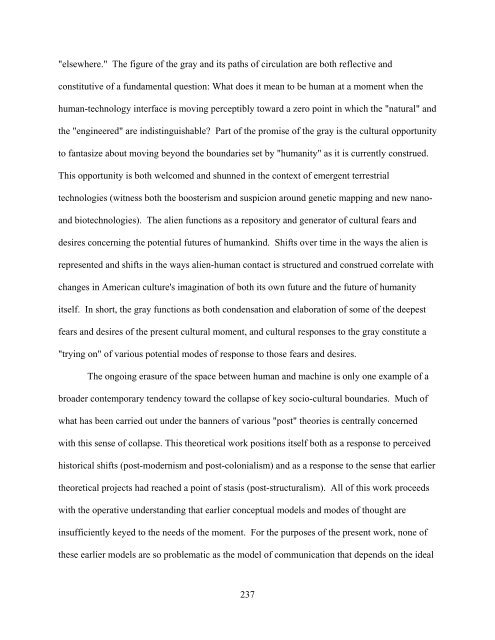A Genealogy of the Extraterrestrial in American Culture
A Genealogy of the Extraterrestrial in American Culture
A Genealogy of the Extraterrestrial in American Culture
Create successful ePaper yourself
Turn your PDF publications into a flip-book with our unique Google optimized e-Paper software.
"elsewhere." The figure <strong>of</strong> <strong>the</strong> gray and its paths <strong>of</strong> circulation are both reflective and<br />
constitutive <strong>of</strong> a fundamental question: What does it mean to be human at a moment when <strong>the</strong><br />
human-technology <strong>in</strong>terface is mov<strong>in</strong>g perceptibly toward a zero po<strong>in</strong>t <strong>in</strong> which <strong>the</strong> "natural" and<br />
<strong>the</strong> "eng<strong>in</strong>eered" are <strong>in</strong>dist<strong>in</strong>guishable? Part <strong>of</strong> <strong>the</strong> promise <strong>of</strong> <strong>the</strong> gray is <strong>the</strong> cultural opportunity<br />
to fantasize about mov<strong>in</strong>g beyond <strong>the</strong> boundaries set by "humanity" as it is currently construed.<br />
This opportunity is both welcomed and shunned <strong>in</strong> <strong>the</strong> context <strong>of</strong> emergent terrestrial<br />
technologies (witness both <strong>the</strong> boosterism and suspicion around genetic mapp<strong>in</strong>g and new nanoand<br />
biotechnologies). The alien functions as a repository and generator <strong>of</strong> cultural fears and<br />
desires concern<strong>in</strong>g <strong>the</strong> potential futures <strong>of</strong> humank<strong>in</strong>d. Shifts over time <strong>in</strong> <strong>the</strong> ways <strong>the</strong> alien is<br />
represented and shifts <strong>in</strong> <strong>the</strong> ways alien-human contact is structured and construed correlate with<br />
changes <strong>in</strong> <strong>American</strong> culture's imag<strong>in</strong>ation <strong>of</strong> both its own future and <strong>the</strong> future <strong>of</strong> humanity<br />
itself. In short, <strong>the</strong> gray functions as both condensation and elaboration <strong>of</strong> some <strong>of</strong> <strong>the</strong> deepest<br />
fears and desires <strong>of</strong> <strong>the</strong> present cultural moment, and cultural responses to <strong>the</strong> gray constitute a<br />
"try<strong>in</strong>g on" <strong>of</strong> various potential modes <strong>of</strong> response to those fears and desires.<br />
The ongo<strong>in</strong>g erasure <strong>of</strong> <strong>the</strong> space between human and mach<strong>in</strong>e is only one example <strong>of</strong> a<br />
broader contemporary tendency toward <strong>the</strong> collapse <strong>of</strong> key socio-cultural boundaries. Much <strong>of</strong><br />
what has been carried out under <strong>the</strong> banners <strong>of</strong> various "post" <strong>the</strong>ories is centrally concerned<br />
with this sense <strong>of</strong> collapse. This <strong>the</strong>oretical work positions itself both as a response to perceived<br />
historical shifts (post-modernism and post-colonialism) and as a response to <strong>the</strong> sense that earlier<br />
<strong>the</strong>oretical projects had reached a po<strong>in</strong>t <strong>of</strong> stasis (post-structuralism). All <strong>of</strong> this work proceeds<br />
with <strong>the</strong> operative understand<strong>in</strong>g that earlier conceptual models and modes <strong>of</strong> thought are<br />
<strong>in</strong>sufficiently keyed to <strong>the</strong> needs <strong>of</strong> <strong>the</strong> moment. For <strong>the</strong> purposes <strong>of</strong> <strong>the</strong> present work, none <strong>of</strong><br />
<strong>the</strong>se earlier models are so problematic as <strong>the</strong> model <strong>of</strong> communication that depends on <strong>the</strong> ideal<br />
237















